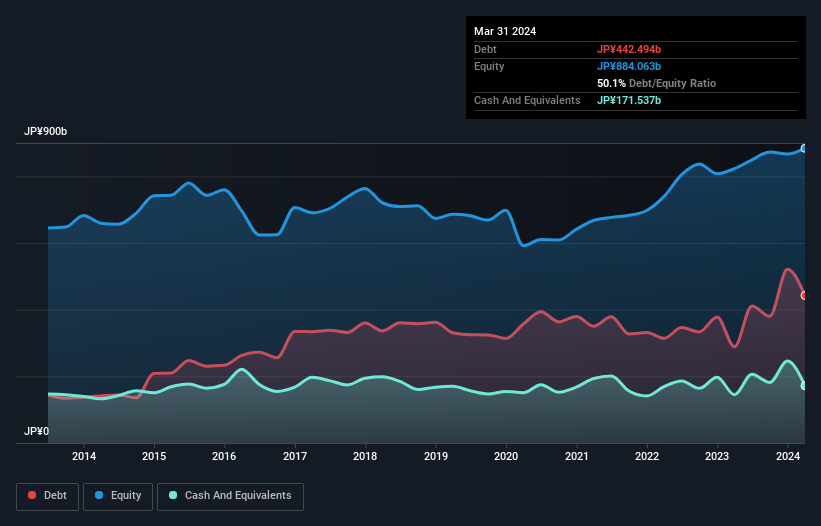
Warren Buffett famously said, 'Volatility is far from synonymous with risk.' So it seems the smart money knows that debt - which is usually involved in bankruptcies - is a very important factor, when you assess how risky a company is. Importantly, Ajinomoto Co., Inc. (TSE:2802) does carry debt. But the more important question is: how much risk is that debt creating?
Why Does Debt Bring Risk?
Debt assists a business until the business has trouble paying it off, either with new capital or with free cash flow. Ultimately, if the company can't fulfill its legal obligations to repay debt, shareholders could walk away with nothing. However, a more frequent (but still costly) occurrence is where a company must issue shares at bargain-basement prices, permanently diluting shareholders, just to shore up its balance sheet. Having said that, the most common situation is where a company manages its debt reasonably well - and to its own advantage. When we think about a company's use of debt, we first look at cash and debt together.
View our latest analysis for Ajinomoto
What Is Ajinomoto's Debt?
As you can see below, at the end of March 2024, Ajinomoto had JP¥442.5b of debt, up from JP¥288.6b a year ago. Click the image for more detail. On the flip side, it has JP¥171.5b in cash leading to net debt of about JP¥271.0b.

A Look At Ajinomoto's Liabilities
We can see from the most recent balance sheet that Ajinomoto had liabilities of JP¥501.5b falling due within a year, and liabilities of JP¥389.0b due beyond that. Offsetting these obligations, it had cash of JP¥171.5b as well as receivables valued at JP¥208.1b due within 12 months. So its liabilities outweigh the sum of its cash and (near-term) receivables by JP¥510.8b.
Given Ajinomoto has a humongous market capitalization of JP¥2.96t, it's hard to believe these liabilities pose much threat. But there are sufficient liabilities that we would certainly recommend shareholders continue to monitor the balance sheet, going forward.
We measure a company's debt load relative to its earnings power by looking at its net debt divided by its earnings before interest, tax, depreciation, and amortization (EBITDA) and by calculating how easily its earnings before interest and tax (EBIT) cover its interest expense (interest cover). The advantage of this approach is that we take into account both the absolute quantum of debt (with net debt to EBITDA) and the actual interest expenses associated with that debt (with its interest cover ratio).
Ajinomoto's net debt is only 1.2 times its EBITDA. And its EBIT easily covers its interest expense, being 31.9 times the size. So you could argue it is no more threatened by its debt than an elephant is by a mouse. Also good is that Ajinomoto grew its EBIT at 13% over the last year, further increasing its ability to manage debt. When analysing debt levels, the balance sheet is the obvious place to start. But ultimately the future profitability of the business will decide if Ajinomoto can strengthen its balance sheet over time. So if you want to see what the professionals think, you might find this free report on analyst profit forecasts to be interesting.
Finally, a company can only pay off debt with cold hard cash, not accounting profits. So it's worth checking how much of that EBIT is backed by free cash flow. Over the most recent three years, Ajinomoto recorded free cash flow worth 52% of its EBIT, which is around normal, given free cash flow excludes interest and tax. This cold hard cash means it can reduce its debt when it wants to.
Our View
Happily, Ajinomoto's impressive interest cover implies it has the upper hand on its debt. And we also thought its EBIT growth rate was a positive. Taking all this data into account, it seems to us that Ajinomoto takes a pretty sensible approach to debt. While that brings some risk, it can also enhance returns for shareholders. Above most other metrics, we think its important to track how fast earnings per share is growing, if at all. If you've also come to that realization, you're in luck, because today you can view this interactive graph of Ajinomoto's earnings per share history for free.
If, after all that, you're more interested in a fast growing company with a rock-solid balance sheet, then check out our list of net cash growth stocks without delay.
New: Manage All Your Stock Portfolios in One Place
We've created the ultimate portfolio companion for stock investors, and it's free.
• Connect an unlimited number of Portfolios and see your total in one currency
• Be alerted to new Warning Signs or Risks via email or mobile
• Track the Fair Value of your stocks
Have feedback on this article? Concerned about the content? Get in touch with us directly. Alternatively, email editorial-team (at) simplywallst.com.
This article by Simply Wall St is general in nature. We provide commentary based on historical data and analyst forecasts only using an unbiased methodology and our articles are not intended to be financial advice. It does not constitute a recommendation to buy or sell any stock, and does not take account of your objectives, or your financial situation. We aim to bring you long-term focused analysis driven by fundamental data. Note that our analysis may not factor in the latest price-sensitive company announcements or qualitative material. Simply Wall St has no position in any stocks mentioned.
About TSE:2802
Ajinomoto
Engages in the seasonings and foods, frozen foods, and healthcare and other businesses in Japan and internationally.
Excellent balance sheet average dividend payer.
Similar Companies
Market Insights
Community Narratives



